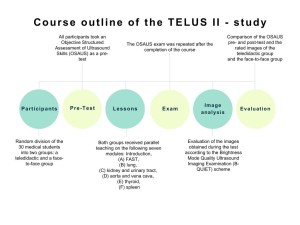Congress:
ECR25
Poster Number:
C-14709
Type:
Poster: EPOS Radiologist (scientific)
Authorblock:
E. Höhne1, F. Recker2, P. Brossart2, V. Schäfer2; 1Frankfurt/DE, 2Bonn/DE
Disclosures:
Elena Höhne:
Nothing to disclose
Florian Recker:
Nothing to disclose
Peter Brossart:
Nothing to disclose
Valentin Schäfer:
Nothing to disclose
Keywords:
Abdomen, Lung, Ultrasound physics, Teleradiology, Ultrasound, Education, Education and training
Simultaneously, teledidactic and face-to-face ultrasound courses were conducted, with students completing seven 90-minute modules using handheld ultrasound probe.

Fig 1: The graphic illustrates the process of teaching ultrasound skills online. While students practiced independently, they shared their camera feed with the instructor, enabling real-time guidance and feedback on probe handling when needed. For demonstrations, the instructor shared their iPad screen with the students, helping them identify the anatomical structures to be visualized. Afterward, students uploaded their images to the app's cloud, where the instructor provided comments and ratings on their work.

Fig 2: The timeline of the TELUS-II study outlines the procedures used to evaluate the efficiency of the teaching methods. Both the teledidactic and face-to-face courses were conducted simultaneously, with students completing weekly modules. The final examinations took place over two consecutive days after the eight-week course duration. Abbreviations: FAST (Focused Assessment with Sonography for Trauma), OSAUS (Objective Structured Assessment of Ultrasound Skills), and B-QUIET (Brightness Mode Quality Ultrasound Imaging Examination Technique).